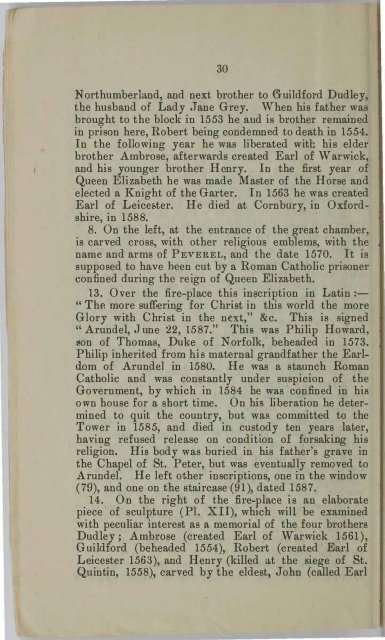Authorised Guide to the Tower of London
You also want an ePaper? Increase the reach of your titles
YUMPU automatically turns print PDFs into web optimized ePapers that Google loves.
30<br />
Northumberland, and next bro<strong>the</strong>r <strong>to</strong> fluildford Dudley,<br />
<strong>the</strong> husband <strong>of</strong> Lady Jane Grey. When his fa<strong>the</strong>r was<br />
brought <strong>to</strong> <strong>the</strong> block in 1553 he and is bro<strong>the</strong>r remained<br />
in prison here, Robert being condemned <strong>to</strong> death in 1554.<br />
In <strong>the</strong> following year he was liberated with his elder<br />
bro<strong>the</strong>r Ambrose, afterwards created Earl <strong>of</strong> Warwick,<br />
and his younger bro<strong>the</strong>r Henry. In <strong>the</strong> first year <strong>of</strong><br />
Queen Elizabeth he was made Master <strong>of</strong> <strong>the</strong> Horse and<br />
elected a Knight <strong>of</strong> <strong>the</strong> Garter. In 1563 he was created<br />
Earl <strong>of</strong> Leice(;ter. He died at Cornbury, in Oxfordshire,<br />
in 1588.<br />
8. On <strong>the</strong> left, at <strong>the</strong> entrance <strong>of</strong> <strong>the</strong> great chamber,<br />
is carved cross, with o<strong>the</strong>r religious emblems, with <strong>the</strong><br />
name and arms <strong>of</strong> PEVEREL, and <strong>the</strong> date 1570. It is<br />
supposed <strong>to</strong> have been cut by a Roman Catholic prisoner<br />
confined during <strong>the</strong> reign <strong>of</strong> Queen Elizabeth.<br />
13. Over <strong>the</strong> fire-place this inscription in Latin :<br />
" The more suffering for Christ in this world <strong>the</strong> more<br />
Glory with Christ in <strong>the</strong> next, " &c. This is signed<br />
"Arundel, June 22, 1587." This was Philip Howard,<br />
son <strong>of</strong> Thomas, Duke <strong>of</strong> Norfolk, beheaded in 1573.<br />
Philip inherited from his maternal grandfa<strong>the</strong>r <strong>the</strong> Earldom<br />
<strong>of</strong> Arundel in 1580. He was a staunch Roman<br />
Catholic and was constantly under suspicion <strong>of</strong> <strong>the</strong><br />
Government, by which in 1584 he was confined in his<br />
own house for a short time. On his liberation he determined<br />
<strong>to</strong> quit <strong>the</strong> country, but was committed <strong>to</strong> <strong>the</strong><br />
<strong>Tower</strong> in 1585, and died in cus<strong>to</strong>dy ten years later,<br />
having refused release on condition <strong>of</strong> forsaking his<br />
religion. His body was buried in his fa<strong>the</strong>r's grave in<br />
<strong>the</strong> Chapel <strong>of</strong> St. Peter, but was eventually removed <strong>to</strong><br />
Arundel. He left o<strong>the</strong>r inscriptions, one in <strong>the</strong> window<br />
(79), and one on <strong>the</strong> staircase (91), dated 1587.<br />
14. On <strong>the</strong> right <strong>of</strong> <strong>the</strong> fire-place is an elaborate<br />
piece <strong>of</strong> sculpture ( Pl. XII), which will be examined<br />
with peculiar interest as a memorial <strong>of</strong> <strong>the</strong> four bro<strong>the</strong>rs<br />
Dudley; Ambrose (created Earl <strong>of</strong> Warwick 1561 ),<br />
Guildford (beheaded 1554), Robert (created Earl <strong>of</strong><br />
Leicester 1563), and Henry (killed at <strong>the</strong> siege <strong>of</strong> St.<br />
Quintin, 1558), carved by <strong>the</strong> eldest, John (called Earl



